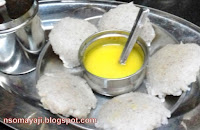Normally curry /Huli means vegetables cooked with toor dal and mixed with spices grinding with coconut. Use of coconut is more in Dakshina Kannada /Mangalore/Udupi and Malenadu areas. Reason may be the life style, the weather, the food and the workload. It was those days people did very hard work, so that they could digest the food they eat. Use of coconut in cooking is very healthy habit, since coconut is full of minerals and vitamins. It is rich in fiber and easy to digest. Help to produce good cholesterol and helps in the growth of good hormones.
I have used fresh grated coconut, fresh rasam powder, seeme badane/chayote squash little jeera.
Let us see the recipe now :
No Onion or No garlic in this Seeme Badane Curry.
Things Needed :
To Cook :Seeme badane /Chayote Squash : 2
Fresh Peas : 1 Cup
To grind :
Fresh grated coconut : 1Cup
Rasam Powder : 2 Teaspoons
Tamarind : A small marble size
To Add :
Turmeric powder : A pinch
Salt : As required
Ghee : 1 Teaspoon
Methi seeds : 5 to 6
Seasoning :
Coconut Oil : 1 Teaspoon
Mustard seeds : 1/2 Teaspoon
Ingh / Asafoetida : A pinch
Curry leaves : 6 to 8
Method :
1. Wash and remove the seeme badane outer layer. Remove the pea pods and wash it.2. Remove the seed in side and cut them into small pieces.
3. Pressure cook for 2 to 3 minutes. Put off the gas. ( You can cook separately with out using pressure cooker. ( Optional ).
4. Grate coconut and grind it with rasam powder and tamarind. (Remove tamarind pod if it is inside).
5. Keep a pan on the fire and put cooked seeme badane and peas. Add salt, turmeric powder and mix it. Cook for 2 minutes. Add dry methi seeds.
6. Add ground coconut - rasam powder mixture and mix it well. Let it boil for 2 to 3 minutes.
7. Shift the curry to a serving dish and add seasoning.
8. Serve with the main dish you have prepared.
Note :
Use of pressure cooker to cook vegetables is optional.Use of any cooking oil for seasoning is optional.
Use of tamarind pulp instead of tamarind is optional. Soak tamarind in hot water and squeeze out the pulp and use it.
Use of any brand rasam powder instead of fresh rasam powder is optional.
Time : 30 Minutes.
Serves : 3 to 4 People.
























































